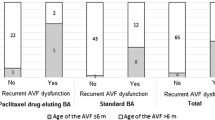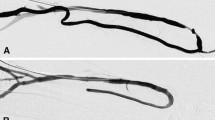Abstract
Purpose
To study the safety and efficacy of cutting balloon angioplasty (CBA) followed by paclitaxel drug-coated balloon (PCB) angioplasty for recurrent venous lesions in arteriovenous fistulas (AVFs).
Materials and Methods
We conducted a prospective single-arm cohort study of CBA followed by PCB angioplasty for recurrent AVF stenoses between September 2017 and April 2019. In total, 44 participants were recruited. Target lesions were included if they had recurred within 12 months post-angioplasty, were > = 0.5 cm upstream from the arteriovenous anastomosis, and did not involve the central veins. Up to two non-target lesions per circuit/participant with the same definition were allowed. Lesions were considered separate when there was an intervening 2-cm segment of normal vessel. Technical success was defined as complete lesion effacement on angioplasty. End-points of target and circuit patency were evaluated clinically at 3, 6, and 12 months post-procedure.
Result
Technical success was 96% (42/44): Two participants were excluded from analysis due to the need for high-pressure balloon angioplasty as the target lesions did not efface with CBA. The median follow-up duration was 337.5 days. Mean stenosis pre- and post-angioplasty was 69.0% (51.6–84.8) and 20.8% (0–44.8), respectively. The target lesion primary, primary assisted and circuit patency for the entire study population (n = 42) were 61.6 ± 7.8%, 92.7 ± 4.0%, and 54.7 ± 7.9%, respectively, at 12 months. For participants without non-target lesions (n = 22), the rates were 77.3 ± 8.9%, 90.9 ± 6.1%, and 60.7 ± 11.0%, respectively, at 12 months.
Conclusion
CBA followed by PCB angioplasty appears safe and feasible for treatment of recurrent venous lesions in dysfunctional AVFs.



Similar content being viewed by others
Change history
15 February 2022
A Correction to this paper has been published: https://doi.org/10.1007/s00270-022-03088-0
References
Daugirdas JT, Depner TA, Inrig J, Mehrotra R, Rocco MV, Suri RS, Weiner DE, Greer N, Ishani A, MacDonald R, Olson C, Rutks I, Slinin Y, Wilt TJ, Rocco M, Kramer H, Choi MJ, Samaniego-Picota M, Scheel PJ, Willis K, Joseph J, Brereton L. KDOQI clinical practice guideline for hemodialysis adequacy: 2015 update. Am J Kidney Dis. 2015;66(5):884–930.
Glanz S, Gordon DH, Butt KM, Hong J, Lipkowitz GS. The role of percutaneous angioplasty in the management of chronic hemodialysis fistulas. Ann Surg. 1987;206(6):777–81.
Schwab SJ, Raymond JR, Saeed M, Newman GE, Dennis PA, Bollinger RR. Prevention of hemodialysis fistula thrombosis. Early Detect Venous Stenoses, Kidney Int. 1989;36(4):707–11.
P.P.G.M. Rooijens, J.H.M. Tordoir, T. Stijnen, J.P.J. Burgmans, A.A.E.A. Smet de, T.I. Yo, Radiocephalic wrist arteriovenous fistula for hemodialysis: meta-analysis indicates a high primary failure rate. Eur J Vasc Endovasc Surg, 28(6) (2004) 583–589.
Roy-Chaudhury P, Sukhatme VP, Cheung AK. Hemodialysis vascular access dysfunction: a cellular and molecular viewpoint. J Am Soc Nephrol. 2006;17(4):1112–27.
Chen B, Wang P, Brem A, Dworkin L, Liu Z, Gong R. Mineralocorticoid receptor: a hidden culprit for hemodialysis vascular access dysfunction. EBioMedicine. 2019;39:621–7.
Chang C-J, Ko P-J, Hsu L-A, Ko Y-S, Ko Y-L, Chen C-F, Huang C-C, Hsu T-S, Lee Y-S, Pang J-HS. Highly increased cell proliferation activity in the restenotic hemodialysis vascular access after percutaneous transluminal angioplasty: implication in prevention of restenosis. Am J Kidney Dis. 2004;43(1):74–84.
Peregrin JH, Roček M. Results of a peripheral cutting balloon prospective multicenter European registry in hemodialysis vascular access. Cardiovasc Intervent Radiol. 2007;30(2):212–5.
Aftab SA, Tay KH, Irani FG, Gong Lo RH, Gogna A, Haaland B, Tan SG, Chng SP, Pasupathy S, Choong HL, Tan BS. Randomized clinical trial of cutting balloon angioplasty versus high-pressure balloon angioplasty in hemodialysis arteriovenous fistula stenoses resistant to conventional balloon angioplasty. J Vasc Interv Radiol. 2014;25(2):190–8.
Irani FG, Teo TKB, Tay KH, Yin WH, Win HH, Gogna A, Patel A, Too CW, Chan S, Lo RHG, Toh LHW, Chng SP, Choong HL, Tan BS. Hemodialysis arteriovenous fistula and graft stenoses: randomized trial comparing drug-eluting balloon angioplasty with conventional angioplasty. Radiology. 2018;289(1):238–47.
Lookstein RA, Haruguchi H, Ouriel K, Weinberg I, Lei L, Cihlar S, Holden A. Drug-coated balloons for dysfunctional dialysis arteriovenous fistulas. N Engl J Med. 2020;383(8):733–42.
Trerotola SO, Saad TF, Roy-Chaudhury P. The lutonix av randomized trial of paclitaxel-coated balloons in arteriovenous fistula stenosis: 2-year results and subgroup analysis. J Vasc Interv Radiol. 2020;31(1):1-14.e5.
Rajabi-Jaghargh E, Banerjee RK. Combined functional and anatomical diagnostic endpoints for assessing arteriovenous fistula dysfunction. World J Nephrol. 2015;4(1):6–18.
Quencer KB, Arici M. Arteriovenous fistulas and their characteristic sites of stenosis. Am J Roentgenol. 2015;205(4):726–34.
Jennings WC, Galt SW, Shenoy S, Wang S, Ladenheim ED, Glickman MH, Kathuria P, Browne BJ. The Venous Window Needle Guide, a hemodialysis cannulation device for salvage of uncannulatable arteriovenous fistulas. J Vasc Surg. 2014;60(4):1024–32.
Gray RJ, Sacks D, Martin LG, Trerotola SO. Reporting standards for percutaneous interventions in dialysis access. J Vasc Interv Radiol. 2003;14(9):S433–42.
F.G. Irani, B.S. Tan, Drug coated balloons: are they the holy grail for dysfunctional dialysis arteriovenous fistulas?, CardioVascular and Interventional Radiology (2020).
Cejna M. Cutting balloon: review on principles and background of use in peripheral arteries. Cardiovasc Intervent Radiol. 2005;28(4):400–8.
Saleh HM, Gabr AK, Tawfik MM, Abouellail H. Prospective, randomized study of cutting balloon angioplasty versus conventional balloon angioplasty for the treatment of hemodialysis access stenoses. J Vasc Surg. 2014;60(3):735–40.
Rasuli P, Chennur VS, Connolly MJ, Hadziomerovic A, Pomerleau FE, Ryan SE, French GJ, O’Kelly K, Aina R, Champagne P, Petrcich W. Randomized trial comparing the primary patency following cutting versus high-pressure balloon angioplasty for treatment of de novo venous stenoses in hemodialysis arteriovenous fistulae. J Vasc Interv Radiol. 2015;26(12):1840-6.e1.
Vesely TM, Siegel JB. Use of the peripheral cutting balloon to treat hemodialysis-related stenoses. J Vasc Interv Radiol. 2005;16(12):1593–603.
Ierardi AM, Franchin M, Fontana F, Piffaretti G, Duka E, Tonolini M, Miele V, Tozzi M, Carrafiello G. Usefulness of paclitaxel-releasing high-pressure balloon associated with cutting balloon angioplasty for treatment of outflow stenoses of failing hemodialysis arteriovenous shunts. Radiol Med. 2017;122(1):69–76.
Zheng J, Cui J, Meiyan Qing J, Irani Z. Safety and effectiveness of combined scoring balloon and paclitaxel-coated balloon angioplasty for stenosis in the hemodialysis access circuit. Diagn Inter Imaging. 2019;100(1):31–7.
Funding
Cutting balloons and drug-coated balloons are sponsored by a research grant from Boston Scientific Corporation.
Author information
Authors and Affiliations
Corresponding author
Ethics declarations
Conflict of interest
The authors declare that they have no conflict of interest.
Ethical Approval
All procedures performed in studies involving human participants were in accordance with the ethical standards of the Singhealth Centralized Institutional Review Board (CIRB reference number: 2017/2026) and with the 1964 Helsinki declaration and its later amendments or comparable ethical standards.
Informed Consent
Informed consent was obtained from all individual participants included in the study.
Additional information
Publisher's Note
Springer Nature remains neutral with regard to jurisdictional claims in published maps and institutional affiliations.
The original online version of this article was revised: The affiliations for two of the authors were mistakenly switched in the initial publication prior to revision on 15 February 2022. The affiliation for the author “Chieh Suai Tan” should be “Department of Renal Medicine” and “Tze Tec Chong” should be “Department of Vascular Surgery”.
Rights and permissions
About this article
Cite this article
Tan, Z., Chan, S.X.J.M., Da Zhuang, K. et al. Recurrent Stenoses in Arteriovenous Fistula (AVF) for Dialysis Access: cuttIng ballooN angioplaSTy combined wITh paclitaxel drUg-coaTed balloon angioplasty, an observatIONal study (INSTITUTION Study). Cardiovasc Intervent Radiol 45, 646–653 (2022). https://doi.org/10.1007/s00270-021-03030-w
Received:
Accepted:
Published:
Issue Date:
DOI: https://doi.org/10.1007/s00270-021-03030-w




